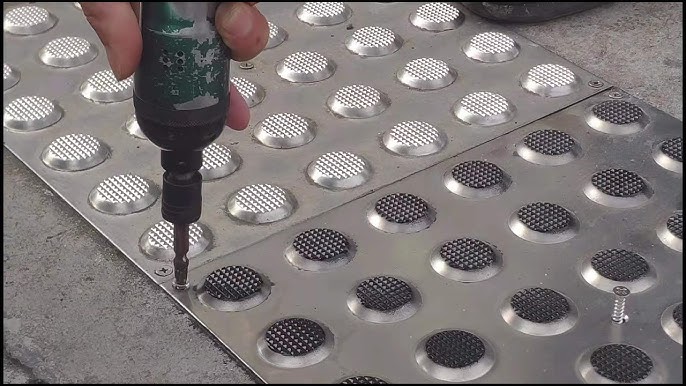
Tactile Indicator Studs (TIS) are an integral part of modern urban landscapes, designed to aid visually impaired individuals in navigating public spaces safely. These studs, often felt underfoot, provide tactile feedback, alerting users to potential hazards or changes in their environment, such as pedestrian crossings, train platform edges, and steps.
History and Evolution of Tactile Indicator Studs
The concept of tactile paving dates back to the mid-20th century, with the first notable implementation in Japan to assist visually impaired pedestrians. Over the years, the design and application of TIS have evolved, with a focus on improving functionality and inclusivity in public infrastructure.
Types of Tactile Indicator Studs: Exploring Varieties and Uses
Warning Studs (Blister Surface)
- Description: Characterized by raised, truncated domes.
- Purpose: To alert visually impaired individuals of potential hazards.
- Common Locations: Pedestrian crossings, top of staircases, and platform edges at train stations.
- Materials: Often made from durable, slip-resistant materials like rubber, concrete, or metal.
Off-Street Road Studs
- Description: Often a variation of warning or directional studs but designed for off-street or less urban environments.
- Purpose: To aid navigation in parks, outdoor recreational areas, or in certain workplaces.
- Materials: Usually designed to be more robust to withstand natural elements and heavy foot traffic.
Corduroy Hazard Warning Surface Studs
- Description: Characterized by closely spaced rows of raised, rectangular bars.
- Purpose: To warn of a hazard, such as stairs, level crossings, or the edge of a train platform.
Color Contrast Studs
- Description: Similar in texture to other studs but with a significant focus on color contrast.
- Purpose: To assist those with partial sight in addition to providing tactile cues.
- Materials & Considerations: The color choice is crucial and is often mandated by local or national standards to ensure visibility and contrast.
Design and Material Considerations: What Makes an Effective Tactile Indicator Stud
Effective TIS are made from durable, slip-resistant materials like stainless steel, rubber, or polyurethane. The design must ensure clear tactile contrast with the surrounding surface while considering aesthetic integration into the urban landscape.
Installation Process: Step-by-Step Guide to Properly Installing Tactile Studs

- Site Preparation:
- Clean and prepare the installation area, ensuring the surface is even and free of debris.
- Marking the Layout:
- Accurately measure and mark the positions for the studs, adhering to required spacing and alignment standards.
- Selecting and Preparing Studs:
- Choose the correct type of tactile studs for the specific location and purpose.
- Prepare the studs for installation, which may include applying adhesive if needed.
- Installing the Studs:
- Place and secure each stud onto the marked positions using adhesive or mechanical fasteners.
- Alignment Check:
- Continuously check and adjust the alignment and spacing of the studs during installation.
- Final Inspection:
- Conduct a thorough inspection to ensure all studs are securely installed and properly aligned.
- Post-Installation Testing:
- Test the installation for proper tactile feedback and safety.
Benefits for Visually Impaired Individuals: Enhancing Mobility and Independence
Tactile studs play a crucial role in empowering visually impaired individuals by enhancing their mobility and independence in public spaces. This part of the blog will focus on the benefits these studs provide, including increased confidence in navigating unfamiliar areas and the reduction of accidents and injuries.
Conclusion: Summarizing the Impact and Necessity of Tactile Indicator Studs
Tactile Indicator Studs are more than just elements of urban design; they are essential tools for accessibility and safety. Their thoughtful implementation reflects a society’s commitment to inclusivity, ensuring that public spaces are navigable and welcoming for all members of the community.
The main types include warning studs, off-street road studs, corduroy hazard warning studs, and color contrast studs — each serving specific functions for navigation and safety.
Tactile indicator studs help visually impaired individuals detect hazards or direction changes in public areas such as crossings, stairways, and train platforms, enhancing safety and mobility.
They are commonly installed at pedestrian crossings, train and bus stations, public building entrances, staircases, and walkways to guide visually impaired pedestrians safely.
Tactile studs are made from durable materials like stainless steel, brass, polyurethane (PU), concrete, or rubber. Stainless steel and PU are most popular for their strength and anti-slip properties.
Yes. Most countries, including Australia, the USA, and the UK, require tactile studs in public spaces under accessibility laws such as the ADA, DDA, and AS/NZS 1428.4.1 standards.
They provide tactile and visual cues that alert users to hazards or path changes, helping visually impaired individuals move confidently and independently in public areas.
You can purchase premium tactile indicator studs from Eminent Tactiles, a trusted manufacturer offering stainless steel, brass, and polyurethane tactile indicators designed for accessibility and safety.
- History and Evolution of Tactile Indicator Studs
- Types of Tactile Indicator Studs: Exploring Varieties and Uses
- Design and Material Considerations: What Makes an Effective Tactile Indicator Stud
- Installation Process: Step-by-Step Guide to Properly Installing Tactile Studs
- Legal Requirements and Standards: Navigating Compliance and Safety Regulations
- Benefits for Visually Impaired Individuals: Enhancing Mobility and Independence
- Conclusion: Summarizing the Impact and Necessity of Tactile Indicator Studs

offer now at
Our Clients





































